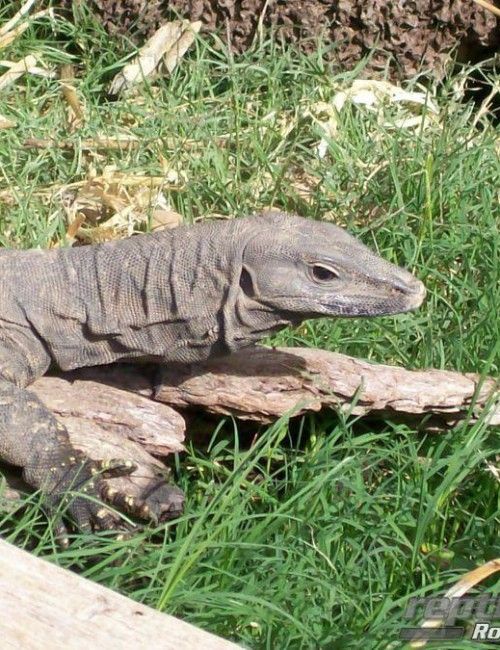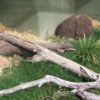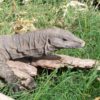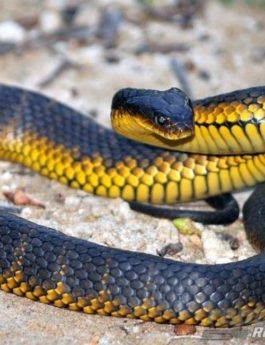Large monitor with long laterally compressed tail. Ground colour dark grey to black, peppered with yellow to grey. Pattern prominent to obscure, consisting of transversely aligned yellow spots or narrow blackish bands; approximately 4 on neck (each curving forward laterally) and approximately 12 on body. Head blackish bearing pale-edged black streak from in front of eye to above and behind ear. Lips barred with blackish brown and greyish white. Limbs black, spotted with yellow to cream. Tail dull yellow marked with approximately 25 pairs of narrow dark bands extending to tip; occasionally tip uniformly dark. Ventral surfaces yellowish to cream, marked with black to dark grey reticulum; occasionally broken to form bands or chevron on chin and throat.
Excavates shallow, slightly curved burrow with expanded terminal cavity, usually adjacent to dense low vegetation. Humid to semi-arid heathlands and woodlands (extending into wet sclerophyll forests in far south-west of range), favouring sandy soils. Extends from southern WA, north to about Perth and east to SA border. Isolated populations occur from south-eastern SA to Big Desert, Vic., and in Goulbun, Nowra and Sydney areas, NSW.
Terrarium: there are several terrariums of different sizes available, the required size will vary based on number of and age/size of the Southern Heath Monitor. Terrariums should be large enough to maintain a correct thermal gradient in ambient air temperatures, this means that the Monitor can regulate its body temperature throughout the enclosure. For a single average size mature Southern Heath Monitor, we wouldn’t recommend anything smaller than 120x60x60cm (WxDxH), and for a pair of adult heath Monitors an escape proof outdoor enclosure would be suitable, as these can be very large lizards, its important to provide enough room for each individual monitor.
Lighting & heating: Southern Heath Monitors are a ‘Day Active’ lizard, meaning they are Diurnal and therefore require high spectrum UVB lighting as well as an intense basking heat source. There are a number of ways to provide UVB, fluorescent 10.0 spectrum tubes or bulbs will provide UVB, a ‘daylight basking’ heat globe will have to be used in conjunction. A mercury vapour globe will provide intense UVA & UVB light, mercury vapour globes are in our opinion superior to fluorescents as it is a longer lasting globe with more intense UVB output, however they cannot be used with a thermostat so work better with a larger enclosure that will easier maintain a thermal gradient. During the day, you want to achieve a basking ‘Hot Spot’ of 38°C and an air temperature ranging from 38°C in the hot end, and down to 25°C in the cool end. A heat rock or heat tile should be provided as tummy heat to help with digestion, this can also be used as a night time heat source. To monitor the temperatures inside the enclosure a thermometer should always be used.
Furnishings: an elevated basking area can be provided using logs, vines or hammocks. Artificial foliage throughout the enclosure will allow the Monitor plenty of hiding spots and coverage, a water bowl placed in the cool end, and red sand kept at the correct moister is our recommended substrate.
Food in captivity: Southern Heath Monitors will eat a variety of insects, including crickets, roaches and silk worms. Mice and raw mince should also be included into their diet. Food items will need to be dusted with calcium and vitamin supplements.
The essentials:
- Terrarium of appropriate size
- High spectrum UVB lighting
- Daytime Basking globe
- Thermometer
- Ground heat
- Water bowl
- Substrate
- Branches/Vines
- Foliage for shelter
- Calcium and vitamin supplements






